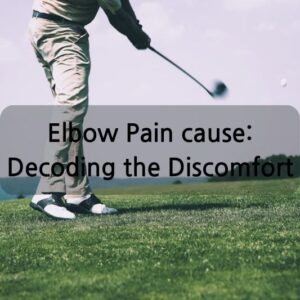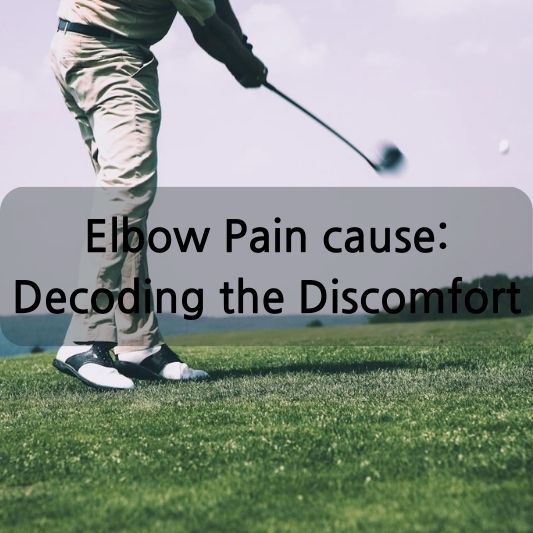Elbow pain, though common, is often underestimated until it interferes with our daily activities. Understanding its causes, symptoms, and effective management is crucial for maintaining overall well-being.

Introduction
The elbow, a pivotal joint in our upper extremity, is susceptible to various issues leading to pain. From overuse injuries to chronic conditions like arthritis, this article will unravel the mysteries surrounding elbow pain.
Understanding Elbow Anatomy
To comprehend the causes of elbow pain, we first need to grasp the intricate anatomy of the elbow joint. Comprising bones, muscles, ligaments, and tendons, the elbow plays a crucial role in our daily movements.
Common Causes of Elbow Pain
Overuse Injuries
Overuse injuries, often seen in athletes and manual laborers, result from repetitive motions, causing strain on the elbow structures.
Arthritis
Arthritis can affect the elbow, leading to pain, inflammation, and limited mobility. Understanding the specific type is vital for effective management.
Fractures and Dislocations
Accidents or falls may result in fractures or dislocations, causing immediate and severe elbow pain.
Tennis Elbow
Lateral epicondylitis, commonly known as tennis elbow, involves inflammation of the outer elbow tendons, often due to repetitive gripping activities.
Golfer’s Elbow
Medial epicondylitis, or golfer’s elbow, is characterized by inner elbow pain, affecting the tendons on the inner side due to repetitive stress.
Bursitis
Inflammation of the fluid-filled sacs (bursae) around the elbow joint can lead to discomfort and restricted movement.
Nerve Compression
Pressure on the nerves around the elbow can cause pain, tingling, and numbness, requiring careful diagnosis for effective treatment.
Recognizing Symptoms
Identifying the symptoms associated with specific causes is pivotal for early intervention. From dull aches to sharp pains, understanding the nuances helps in seeking timely medical advice.
Diagnosing Elbow Pain
Medical professionals utilize various diagnostic tools, including X-rays and MRI scans, to pinpoint the root cause of elbow pain accurately.
Home Remedies for Elbow Pain
Rest and Ice Therapy
Resting the affected elbow and applying ice can alleviate pain and reduce inflammation.
Compression and Elevation
Using compression techniques and elevating the elbow can aid in managing swelling and promoting healing.
Over-the-Counter Pain Relievers
Non-prescription pain relievers can offer temporary relief, but long-term use should be monitored.
Physical Therapy Exercises
Engaging in specific exercises under the guidance of a physiotherapist helps strengthen the elbow and improve flexibility.
Professional Treatment Options
Medications
Prescribed medications, including anti-inflammatory drugs, may be recommended to manage pain and inflammation.
Injections
Corticosteroid injections directly into the affected area can provide targeted relief for certain conditions.
Surgical Interventions
In severe cases, surgical procedures may be necessary to repair damaged structures and restore optimal elbow function.
Preventive Measures
Incorporating simple lifestyle changes and preventive measures can significantly reduce the risk of developing elbow pain.
Lifestyle Changes for Elbow Health
Proper Ergonomics
Ensuring ergonomic workspaces and habits can prevent unnecessary strain on the elbow during daily activities.
Strengthening Exercises
Regularly incorporating exercises that strengthen the muscles around the elbow joint is key to preventing injuries.
Warm-up and Stretching Routines
Warming up before engaging in physical activities and implementing stretching routines enhances flexibility and reduces the risk of injury.
When to Seek Medical Attention
Ignoring persistent elbow pain can lead to complications. Consulting a healthcare professional promptly is crucial for accurate diagnosis and timely treatment.
Case Studies
Real-life case studies provide insights into the diverse causes of elbow pain and the effectiveness of different treatment approaches.
Elbow Pain in Athletes
Athletes often face unique challenges related to elbow pain. Tailored approaches and preventive strategies are essential to keep them in the game.
Coping Strategies for Chronic Elbow Pain
Mental Health Impact
Chronic pain can take a toll on mental well-being. Recognizing and addressing the psychological aspects is integral to comprehensive pain management.
Support Groups and Counseling
Connecting with others experiencing similar challenges and seeking professional counseling can provide emotional support and coping mechanisms.
Alternative Therapies
Exploring alternative therapies, such as acupuncture, chiropractic care, and herbal remedies, can complement traditional treatments for some individuals.
Conclusion
Elbow pain is a common concern, but with proper understanding and proactive measures, it can be effectively managed. Whether through lifestyle changes, professional interventions, or alternative therapies, individuals can regain control over their elbow health.
FAQs
Q: Can elbow pain be a symptom of a more serious underlying condition?
A: Yes, persistent elbow pain should not be ignored, as it could indicate an underlying issue that requires medical attention.
Q: Are there specific exercises to prevent tennis elbow?
A: Strengthening exercises for the forearm and proper technique during activities can help prevent tennis elbow.
Q: How long does it take to recover from a common elbow injury?
A: Recovery time varies depending on the type and severity of the injury. Consultation with a healthcare professional is essential for accurate assessment.
Q: Are there natural remedies for managing arthritis-related elbow pain?
A: Some individuals find relief through dietary changes, supplements, and herbal remedies, but it’s crucial to consult with a healthcare provider.
Q: Can elbow pain affect daily activities and productivity?
A: Yes, severe elbow pain can limit mobility and hinder daily tasks, emphasizing the importance of seeking timely treatment.
Find out the price of nutritional supplements to help with joint health on iHerb!
